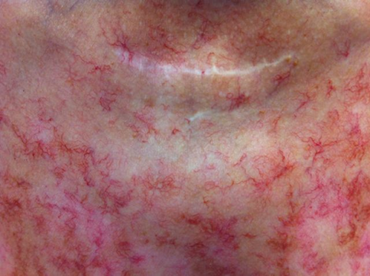TEMPI syndrome
| TEMPI syndrome | |
|---|---|
| Other names: Telangiectasia-erythrocytosis-monoclonal gammopathy-perinephric-fluid collections-intrapulmonary shunting syndrome | |
 | |
| Extensive cutaneous telangiectasia on chest wall. | |
TEMPI Syndrome is an orphan disease where the patients share five characteristics from which the acronym is derived: telangiectasias, elevated erythropoietin and erythrocytosis, monoclonal gammopathy, perinephric fluid collection, and intrapulmonary shunting.
Signs and symptoms
| TEMPI | Symptom |
|---|---|
| T | Telangiectasias |
| E | Elevated Erythropoietin and Erythrocytosis |
| M | Monoclonal gammopathy |
| P | Perinephric fluid collections |
| I | Intrapulmonary shunting |
The patients were all diagnosed at middle age. The symptoms were slowly and steadily progressive. Telangiectasias developed over the face, trunk and arms. Increased serum erythropoietin levels, eventually exceeding 5000 mU /ml, preceded the intrapulmonary shunting and the development of hypoxemia. Sampling of the perinephric fluid revealed a clear, serous fluid with low levels of protein, few leukocytes and no cholesterol or triglycerides. A monoclonal gammopathy was implicated in all patients tested. Spontaneous venous thromboses occurred in some patients, sometimes accompanied with spontaneous intracranial bleeding in the absence of blood vessels malformations.[1]
Cause
The cause of the syndrome is unknown. The abnormal plasma-cell clone and/or the monoclonal gammopathy are suggested to be triggers of the disease.[citation needed]
Diagnosis
The diagnosis is based on the five characteristics described above.[citation needed]
Treatment
Complete and partial disappearance of the symptoms of the TEMPI syndrome was reported with the drugs bortezomib,[2] daratumumab[3] and autologous stem cell transplantation.[4]
History
In 2010, the case of a man with unexplained erythrocytosis and perinephric fluid collection as main features was described in the Case Records of the Massachusetts General Hospital.[5] As a consequence two strikingly similar cases were identified and a review of the literature revealed three more patients with similar characteristics and a novel multisystem disease, the TEMPI syndrome, was reported.[1]
As of January 2020, a total of 22 patients worldwide with the TEMPI syndrome have been identified[citation needed]
References
- ↑ 1.0 1.1 Sykes, David B.; Schroyens, Wilfried; O'Connell, Casey (2011). "TEMPI Syndrome – A Novel Multisystem Disease". N Engl J Med. 365 (5): 475–477. doi:10.1056/NEJMc1106670. PMID 21812700. Archived from the original on 2022-01-11. Retrieved 2021-10-30.
- ↑ Schroyens, Wilfried; O'Connell, Casey; Sykes, David B. (2012). "Complete and Partial Responses of the TEMPI Syndrome to Bortezomib" (PDF). N Engl J Med. 367 (8): 778–780. doi:10.1056/NEJMc1205806. PMID 22913703. Archived from the original on 2022-01-11. Retrieved 2021-10-30.
- ↑ Sykes, David B.; Schroyens, W. (2018). "Complete Responses in the TEMPI Syndrome after Treatment with Daratumumab". N Engl J Med. 378 (23): 2240–2242. doi:10.1056/NEJMc1804415. PMID 29874534.
- ↑ Kenderian, S.S..; Rosado, F.G; Sykes, D.B.; Hoyer, J.D.; Lacy, M.Q. (2015). "Long-term complete clinical and hematological responses of the TEMPI syndrome after autologous stem cell transplantation". Leukemia. 29 (12): 2414–2416. doi:10.1038/leu.2015.298. PMID 26500143.
- ↑ Bazari, Hasan; Attar, Eyal C.; Dahl, Douglas M.; Uppot, Raul N.; Colvin, Robert B. (2010). "Case Records of the Massachusetts General Hospital. Case 23-2010: A 49-Year-Old Man with Erythrocytosis, Perinephric Fluid Collections, and Renal Failure". N Engl J Med. 363 (5): 463–475. doi:10.1056/NEJMcpc1004086. PMID 20818867.
External links
- Office of Rare Diseases Research Archived 2015-09-05 at the Wayback Machine (US)
- Orpha.net Archived 2018-09-16 at the Wayback Machine (EU)
| External resources |
|---|
- Pages with script errors
- All articles with unsourced statements
- Articles with unsourced statements from July 2020
- Articles with invalid date parameter in template
- Articles with unsourced statements from October 2021
- Webarchive template wayback links
- Rare syndromes
- Syndromes of unknown causes
- Syndromes affecting blood
- Syndromes affecting the vascular system